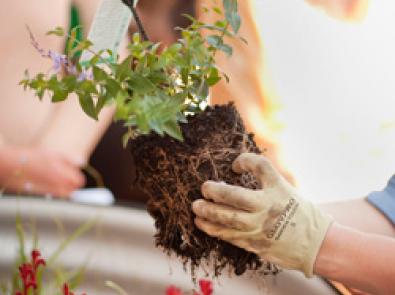Raingardens are self-watering, low-maintenance gardens designed to protect our rivers and creeks, by capturing stormwater that runs off hard surfaces when it rains. Use our resources to build your own raingarden and view examples across Melbourne.
How to build a raingarden
Select a design
Raingardens come in many different shapes and sizes, so choose a design that suits the area where you're capturing stormwater — for example:
- from a downpipe
- near a driveway or patio
- near a rainwater tank to capture overflow
Start construction
Depending on your raingarden type, you'll need to build a planter box or excavate a trench.
A waterproof liner is sometimes used on the outside of raingardens to prevent interaction with soils and groundwater. This:
- protects nearby buildings, foundations or infrastructure
- avoids creating problems with saline groundwater or reactive clays
- captures all stormwater for reuse
If you're building an inground style raingarden (including inground and infiltration raingardens or swales), dig the area with a gentle slope away from the house:
- check the base of the raingarden is above the surrounding groundwater level
- design your raingarden to capture gentle rainfall — runoff from heavy storms should bypass the raingarden into the drainage system
We recommend including a saturated or submerged zone below the raingarden to store water, helping plants survive dry periods and improving the garden's performance. This is especially useful in northern and western Melbourne where there's less rain.
Choose your plants
Be creative with your raingarden design and use a variety of plants, rather than one species, as this prevents die-off and weeds. Your local nursery can suggest plants that suit your area, but make sure they can tolerate both heavy rain and long, dry periods. Native plants are usually more drought-resistant and low-maintenance than introduced species.
Tips for healthy raingardens
Raingardens are easy to maintain, especially those with native Australian plants; they don't need to be watered, mowed or fertilised. To make sure your raingarden functions well:
- Cover it with gravel mulch to retain moisture (not bark or straw, as these float into the stormwater system).
- Weed it until the plants have matured.
- Distribute water evenly to reduce erosion from heavy rain — strategically placed rocks may help.
- Inspect it regularly and replace plants and repair erosion when needed.
- Don't drive over or squash your raingarden as this reduces its ability to work effectively.
- If it doesn't rain, water your raingarden until your plants have established.
Instruction sheets
The easiest and cheapest way to build a raingarden is to do it yourself following our simple instruction sheets. Materials can be purchased from most hardware or garden supply stores.
You could also contact a landscape gardener for help and expert advice, and licensed plumbers can help modify and divert your stormwater system.
Raingardens in Melbourne
We work with councils and the community to build public raingardens in streets, parks and schools. Examples include:
- Federation Square Carpark Raingarden, Melbourne CBD
Filters stormwater runoff before it enters the Yarra River. Plants used include Gymea Lily or the Giant Spear Lily (Doryanthes excelsa), Blueberry Ash (Elaeocarpus reticulates) and Carex species. - Lambert Street Raingardens, Richmond
Series of street raingardens creating a greener space while filtering stormwater. Plants used include Weeping Bottlebrush (Callistemon viminalis) and Little Rev (Dianella revolute). - Various community raingardens
Includes those located at the Canterbury Neighbourhood Centre, Betty Day Community Centre and Ferntree Gully Library.




